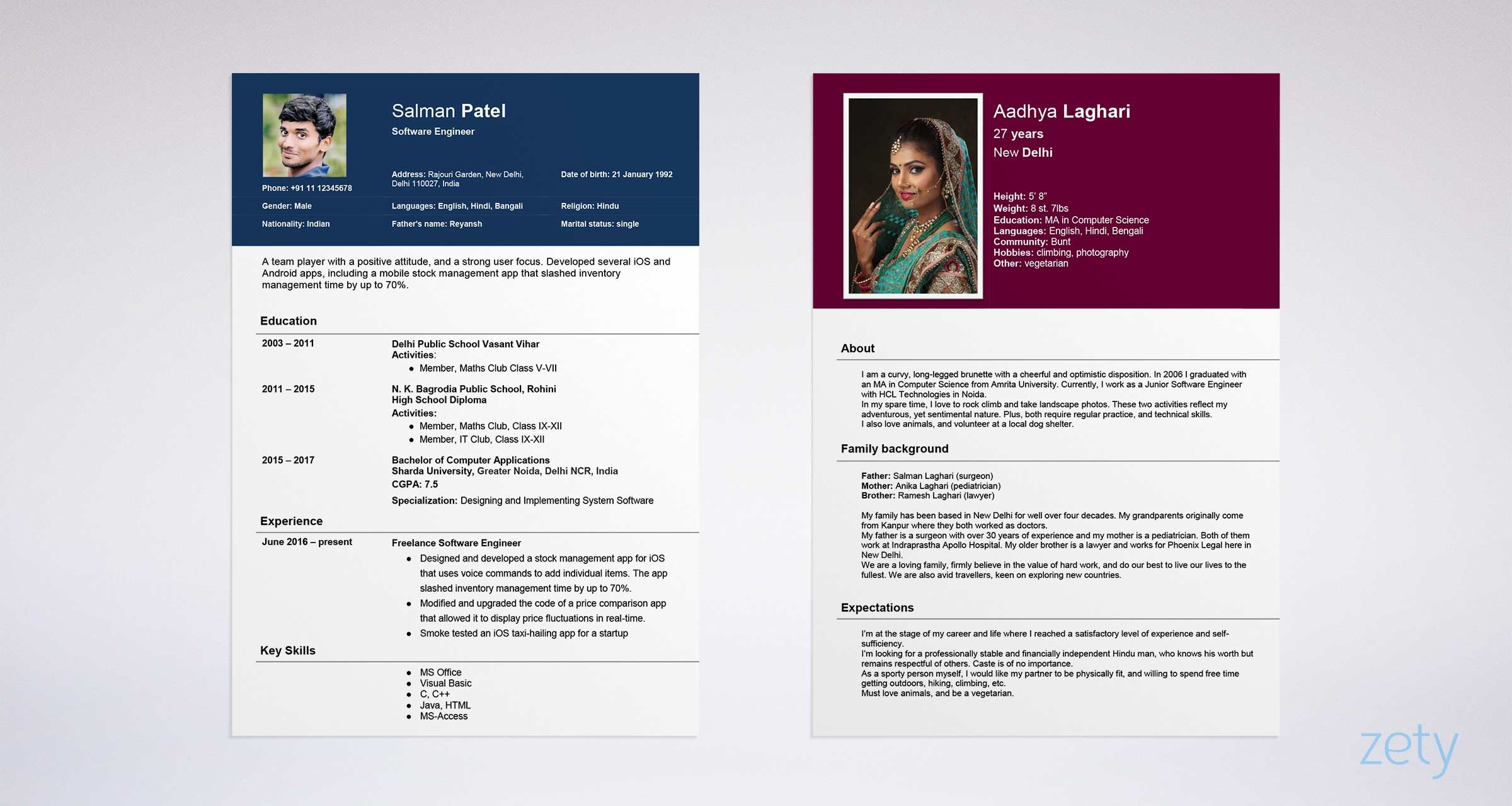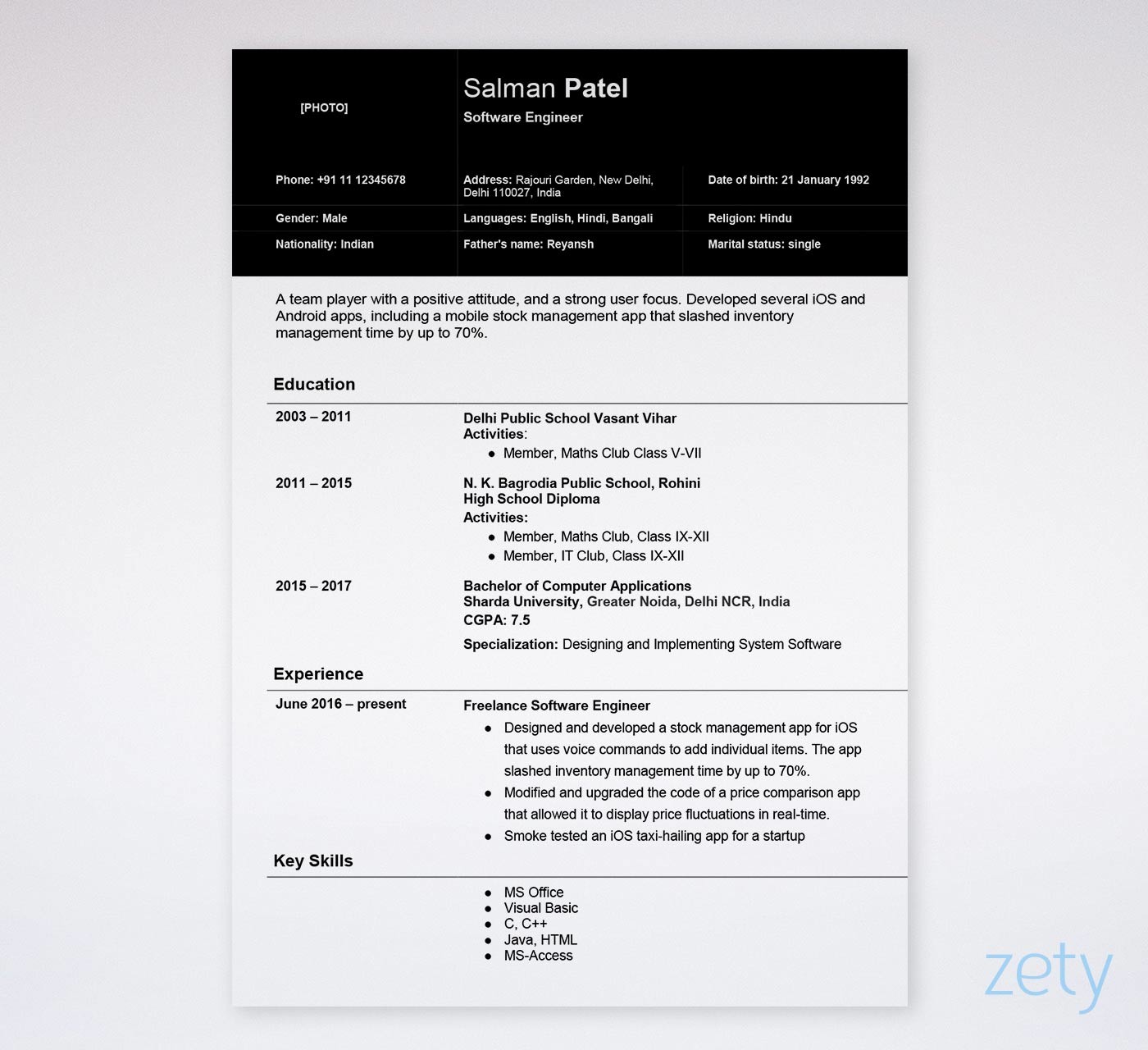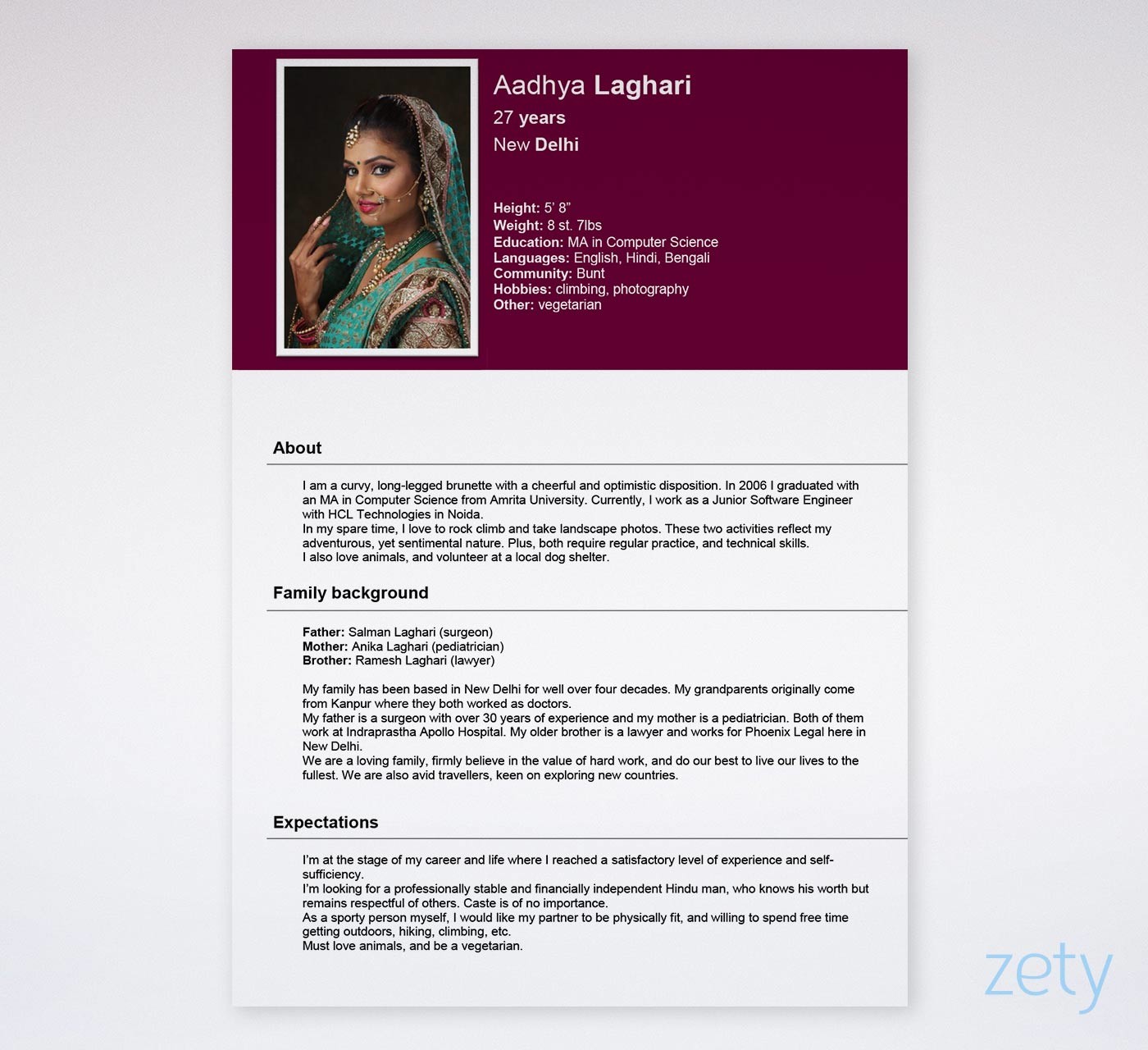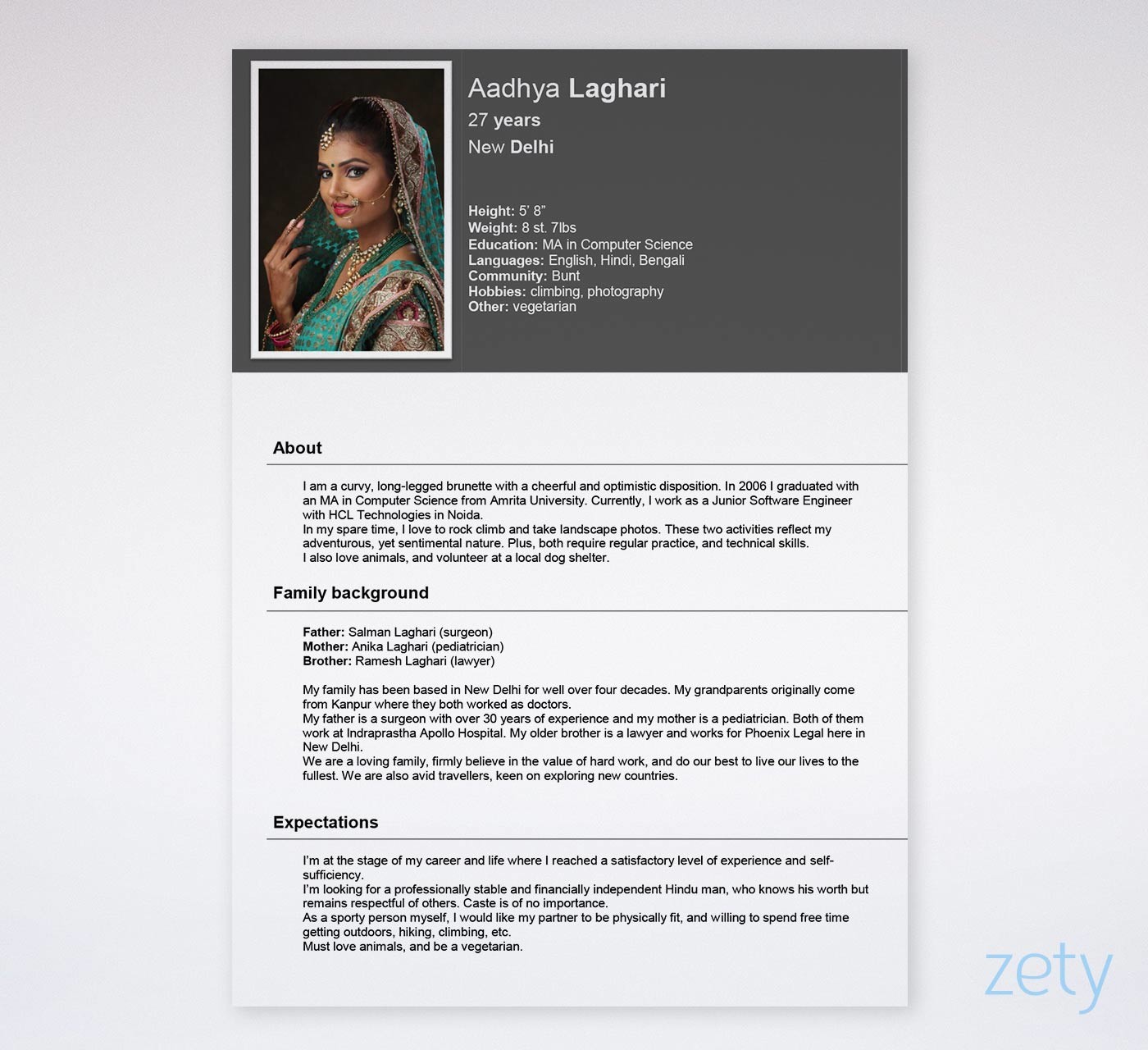Listen,
you're two minutes away from your simple and elegant biodata format.
But first, a short quiz:
What is biodata?
- an alternative word for a resume or CV in South Asia
- a "marriage resume"
- a supplement to a resume
- a kind of form for collecting personal data used in research and certain institutions
5… 4… 3… 2… 1... zero. Time's up!
In fact, all answers are correct. It depends on the context.
Most of the time, though, you will need a biodata to:
- Get a job (mostly in several South Asian regions.)
- Find a spouse.
Reality check:
The competition is fierce out there!
The average recruiter will spend about 6 seconds scanning your biodata format. So, you really need to come across as Sundar Pinchai version 2.0.
And your future spouse?
Well, craft your biodata for marriage so they see Suraj Sharma's potential, or Freida Pinto's grace in you!
This guide will show you:
- The differences between a resume, CV, and biodata.
- What to include in a biodata for job applicants.
- How your biodata for marriage should look.
- Sample biodata format better than 9 out of 10 other ones.
Create your biodata now

Sample Biodata Formats:
Download a FREE biodata format for a job.
Download a FREE biodata format for marriage.
Get it for FREE
If you're looking for a job in America switch over to: How to Write a Resume that Gets You the Job
If it's not the US, but elsewhere around the world see: How to Write a CV for the Job of Your Dreams
If you're looking for resume templates, see:
- Microsoft Word Resume Template
- Best Resume Template
- Creative Resume Template
- Skills Based Resume Template
- Free One Page Resume Template
- Basic Resume Template
1
What is the Difference Between a Resume, CV, and Biodata?
Let's kick off with the similarities.
A resume, CV, and biodata are documents that introduce you to your prospective employer, and give them your contact details. They all reveal something about your experience, skills, and education.
Here are some key differences between a resume, CV, and biodata:
Biodata is a document that focuses on your personal information: date of birth, gender, religion, race, nationality, place of residence, marital status, parents' names, contact details, current position, salary, etc. It may also contain a brief opening statement, your education, and experience in chronological order.
In some South Asian countries (e.g. India, Bangladesh) it is used in the place of a resume. A kind of biodata form may be required when applying for government, or defence positions. Plus, it's widely used for matrimonial purposes in South Asia.
Resume is a short document (1 or 2 pages) used to apply for jobs. It gives future employers a brief overview of your work history. The word resume is originally a French word for "sum up." Your resume focuses on and sums up your job-related accomplishments and experience.
CV (or Curriculum Vitae, Latin for "course of life") is the alternative to a resume. It is a record of your academic and professional achievements. CVs are often longer than resumes, go more into detail, and their length depends on the applicant's experience. In the US, CVs are common when applying for academic jobs, research positions, grants, or scholarships. Elsewhere around the globe, a CV is basically a resume.
And one more thing:
Since the term biodata covers a very broad spectrum of meanings, the look of the biodata formats you come across online may vary hugely.
From formal-looking documents with tables, to lists of assessment questions, to indian resume formats, to marriage resumes.
This guide focuses on the last two types of biodata format:
- a biodata format for job applicants/indian resume format,
- and a biodata format for marriage for a girl and a boy.
Would you'd like to probe the differences between resumes and CVs a little further? Head straight to our guide: CV vs. Resume: What is the Difference? When to Use Which (Examples)
2
What to Include in a Biodata Format for a Job?
Let's face it:
Preparing a biodata format may turn out to be a non-issue.
That's because some employers might already have their own biodata format, which you just need to fill in.
But:
That's not always the case.
And this is exactly when our simple and easy biodata format in MS Word comes in handy!
Here's a look at what your biodata format for a job applicant may look like.
Biodata Format— PDF Sample

Let's have a look at what you may want to include in a successful biodata format for employment.
3
How to Write a Biodata Format to Get What You Want
Let's take it from the top:
1. Start off with an Objective or Summary
This is what appears at the very top of your biodata format.
Think of this section in terms of a movie trailer:
If you show the good stuff, the recruiter will crave to see more!
In general, the opening statements fall into 2 basic categories: an objective or summary.
Here are the key differences:
An objective consists of 2-3 sentences that say why you are a good fit for the position. This kind of opening statement is useful for freshers and those whose experience is limited.
| right |
|---|
| Hard-working IT graduate interested in pursuing a software engineering position. Skilled in mobile app development, specializing in iOS. Eager to develop his programming skills within an expanding IT organization, such as TopApp Inc. |
Make sure your objective presents your strong traits, blends in experience, and shows how you can benefit the company.
A summary also consists of a couple of sentences, but it gives the employer some insight into your experience that matches their requirements.
| right |
|---|
| Software Engineer with 6+ years in the IT industry. Highly skilled in developing and beta-testing mobile apps. Identified up to 90% of software bugs affecting apps' stability. Eager to leverage his coding skills to improve the quality of life of average users, and help company X grow exponentially. |
To write a winning biodata summary, make sure it:
- Focuses on your track-record.
- Specifies your education and/or experience.
- Shows your achievement(s).
- Uses numbers to quantify what's possible.
If you really want your biodata format to stand out, including the opening statement may turn out to be a real game-changer.
If you're not sure how to write your opening statement, jump right into one of our guides: 20+ Resume Objective Examples - Use Them On Your Resume (Tips) and Professional Resume Summary: 30 Examples of Statements [+How-To]
2. Include Personal Information
In contrast to the previous section, this one doesn't leave much room for creativity.
But this is not to say you can just ignore it!
No.
Make sure to include all the relevant information. Double-check the job posting to see if there are any specific requirements for you to follow.
Here's a list of ideas of what you may want to include in your biodata personal information section:
- current position,
- phone number,
- email address,
- contact details,
- place of residence,
- postal address,
- date of birth,
- nationality,
- marital status,
- parents' names,
- gender,
- religion,
- height,
- complexion,
- race,
- salary,
- hobbies,
- interests,
- strengths,
- character traits.
While some of these might be required by the employer (contact details, place of residence, phone number), other items on the list may be optional.
Word of caution: in most western countries, a lot of this information would be considered sensitive and should not be added to your application, especially numbers 7 through 16. And numbers 17 through 20 would look out of place.
Pro Tip: You can easily change your indian resume format into a reverse-chronological resume. Start your education and experience section with the latest school you finished and position you held.
3. Show Off Your Education
This section lists your education in chronological order.
Make it work to your advantage!
Keep it simple, but don't fail to mention coursework and academic achievements relevant to the job on offer.
2003—2011
Delhi Public School Vasant Vihar
Activities:
- Member, Maths Club Class V-VII
2011—2015
1. K. Bagrodia Public School, Rohini
High School Diploma
Activities:
- Member, Maths Club, Class IX-XII
- Member, IT Club, Class IX-XII
2015—2017
Bachelor of Computer Applications
Sharda University,Greater Noida, Delhi NCR, India
CGPA: 7.5
Specialization: Designing and Implementing System Software
Not sure how to list your education?
Here's a guide that will answer all your questions: How to Put Your Education on a Resume [Tips & Examples]
4. Prove Your Experience Is Better
This is where you list your experience in chronological order.
But listen:
Don't just list the names of companies you worked for.
Experience is so much more than that!
First, take a good look at the job posting itself. Does it look anything like that?
Role and Responsibilities:
- Design, develop and maintain applications for various devices.
- Write well-designed, testable code.
- Modifying existing code to add new features
Fish out the skills the recruiters are after.
Based on this particular offer, these would be:
- app design
- app development
- testing
- analysing
- modifying
Now, think about your experience, and craft this section to address exactly the skills sought for.
Indian Resume Samples—Experience
| right |
|---|
| June 2016—present Freelance Software Engineer
|
The key is to tailor-make your biodata by targeting a specific job offer, and demonstrating the skills and experience that the recruiter is seeking.
In the example above, the yellow highlights reflect the skills required for the position on offer.
Pro Tip: The skills you are unable to mix into your experience section can go straight into a separate key skills section at the bottom of your biodata form.
If you're still confused about how to get this section of your biodata form right, this guide will help you: Work Experience on a Resume: Job Description Bullets that *Kill*
If you're a job fresher, go right here: Entry-Level Resume: Sample and Complete Guide
4
How to Fill Out a Biodata Format for Marriage
You might be wondering:
Is a biodata format for marriage the same as biodata format for job applicants?
Hell, no!
It's like asking if an ATV and Bugatti are the same.
Well, both are cars—but serve totally different purposes.
The same is true about a marriage biodata and a biodata format for job applicants.
Just take a look at our sample biodata for marriage.
Marriage Biodata Format PDF

Here are the sections you may want to include in your biodata for marriage:
- Personal information
- Photo
- Your profile
- Family background
- Your expectations
- Horoscope (optional)
Now, let's take a closer look at each of them.
1. Make Sure Your Personal Information Paints a Picture
This section of your matrimonial biodata should offer a taste of things to come.
The trick is to say as much as possible, and use as few words as possible.
Here are a couple of ideas about what you may want to include:
- Name
- Age
- Physical features (height, weight)
- Location
- Education
- Languages spoken
- Community
- Hobbies
- Other relevant information
2. Better yet, include an Actual Picture: a Professional Photo
Let's be honest:
It's the photo that does the trick.
If the reader isn't able to take their eyes off you—they're likely to stick around a bit longer.
And if you choose a passable photo. Well, expect your marriage biodata to be quickly passed over.
So, here's some advice for you to consider:
Don't have a nice portrait picture? Get a photographer to take one!
Don't be tempted to use your smartphone's front facing camera, and put a ton of filters on your image. This doesn't just look bad, but may also make someone think you've enhanced the image too much. Also, make sure it's a color picture and a recent one. If you had a photo taken 5 years ago—just forget it.
Show more than just your face.
It doesn't need to be a full shot showing you head to toe. A medium shot (from the waist up), or a head and shoulder shot will do. You might also want to consider using a collage of a couple of types of pictures. Or even add more pictures of you in a separate attachment.
Don't use a group photo.
Just don't. It's all about you.
3. Wow the Reader in the About Me Section
When preparing this section of your marriage biodata, you can easily assume that you've sparked the reader's interest.
Now, spice things up with some more details about yourself.
In general, it's safe to stick to this structure:
- Appearance and looks
- Education
- Professional status
- Hobbies and interests
- Additional info (optional)
Here's what a description based on this structure may look like in your biodata for marriage:
Matrimonial Profile Sample: About Me
I am a curvy, long-legged brunette with a cheerful and optimistic disposition. In 2006 I graduated with an MA in Computer Science from Amrita University. Currently, I work as a Junior Software Engineer with HCL Technologies in Noida.
In my spare time, I love to rock climb and take landscape photos. These two activities reflect my adventurous, yet sentimental nature. Plus, both require regular practice, and technical skills.
I also love animals, and volunteer at a local dog shelter.
Pro Tip: If you have any physical or mental disabilities do not fail to mention them here.
4. Show How Proud You Are of Your Family Background
In your marriage biodata, your family is just as important as you are. So make sure you approach this section with care and attention.
As a rule, it's good to list information about your immediate family:
- Father's name and occupation
- Mother's name and occupation
- Siblings and their occupations
And add an extra paragraph or two briefly characterizing your family.
It can look something like that:
Family Description for Matrimony Sample
My family has been based in New Delhi for well over four decades. My grandparents originally come from Kanpur where they both worked as doctors.
My father is a surgeon with over 30 years of experience and my mother is a pediatrician. Both of them work at Indraprastha Apollo Hospital. My older brother is a lawyer and works for Phoenix Legal here in New Delhi.
We are a loving family, firmly believe in the value of hard work, and do our best to live our lives to the fullest. We are also avid travellers, keen on exploring new countries.
5. Be Clear About Who You're Looking for (Partner Expectations)
This section of your biodata is where your reader will see if they stand any chances.
Make sure not to skip anything you deem essential in your partner.
In fact, it might be a good idea to make a bullet point list of the qualities you're seeking. Then prune it, and leave the ones you couldn't live without.
Your list could look something like that:
- professionally stable
- financially independent
- Hindu
- confident
- respectful
- loves sports
- likes to spend time outdoors
- animal lover
- vegetarian
Then put them all together and prepare a short description.
I'm at the stage of my career and life where I reached a satisfactory level of experience and self-sufficiency.
I'm looking for a professionally stable and financially independent Hindu man, who knows his worth but remains respectful of others. Caste is of no importance.
As a sporty person myself, I would like my partner to be physically fit, and willing to spend free time getting outdoors, hiking, climbing, etc.
Must love animals, and be a vegetarian.
Pro Tip: You're looking for someone you'd like to spend the rest of your life with. Not an easy friend. Give this section all the attention it calls for. And then a bit more.
6. Match Up via Horoscope If You're a Believer
Here's the thing:
Not everybody believes in horoscope matching.
If you don't—you might just want to mention it at the end of the partner expectations section.
A short sentence that reads "I don't believe in horoscope matching," will do.
But, it's also a good idea to say you're able to provide your horoscope if need be.
This way you express your opinion, and remain respectful.
If you do believe in horoscope matching, simply add this short section to your marriage biodata.
You can stick to this simple format:
Date of birth:
Place of birth:
Time of birth:
Rasi:
Nakshatra:
Key takeaways
In this day and age, a biodata mostly refers to either of these two types of documents:
- Job biodata format—this could range from a kind of resume, to a list of questions for you to answer.
- Matrimonial biodata format—a document presenting your matrimonial profile.
To make your biodata format for job applicants stand out, you might want it to include:
- Personal information
- Objective / Summary
- Education
- Experience
- Key skills
Biodatas usually present your educational background and professional experience in chronological order.
Marriage biodata formats are different. It might be a good idea to include the following sections in your biodata for marriage:
- Personal information
- Photo
- Your profile
- Family background
- Your expectations
- Horoscope (optional)
Use our latest biodata format in Word to prepare yours!
Indian CV Format—PDF Sample

Biodata Format for Marriage for Girl—Marriage Biodata Sample

Do you have your own ideas about making the best biodata possible? Or maybe you want to share your story with us? Give us a shout in the comments section!
Source: https://zety.com/blog/biodata-format
Posted by: kandacekandaceyearouse0267147.blogspot.com